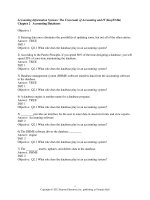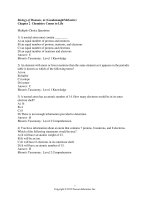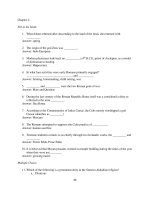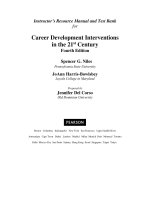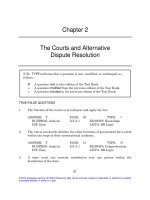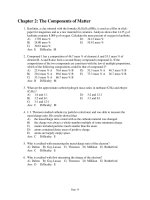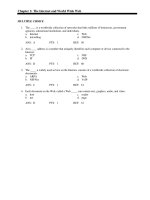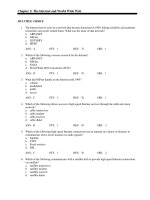Essentials of the living world 4th edition johnson test bank
Bạn đang xem bản rút gọn của tài liệu. Xem và tải ngay bản đầy đủ của tài liệu tại đây (201.67 KB, 16 trang )
Chapter 02 Test Bank
Student: ___________________________________________________________________________
1.
The nucleus of an atom is composed of two subatomic particles, ______________ and ______________.
A. protons; neutrons
B. protons; electrons
C. neutrons; electrons
2.
Atoms that bear a positive or negative charge are known as
A. magnetic.
B. electrically neutral.
C. ions.
D. lacking nuclei.
3.
The ___________________ of atoms determine how atoms will react with each other.
A. protons
B. neutrons
C. nuclei
D. electrons
4.
In a neutral atom, protons are always
A. equal to the electrons.
B. close to the electrons.
C. equal to the neutrons.
D. combined with the electrons to calculate the atomic mass.
5.
The volume of space around a nucleus where an electron is most likely to be located is called the _______________
of that electron.
A. energy level
B. spin
C. pathway
D. orbital
6.
Electrons possess energy of position, also known as _____________ energy.
A. kinetic
B. latent
C. potential
D. opposition
7.
Most elements in nature exist as
A. solitary unreactive atoms.
B. mixtures of different isotopes.
C. mixtures of gases.
D. mixtures of liquids.
8.
What is true about 14C?
A. It is an ion.
B. It is the most common form of carbon.
C. It can be employed in the radioisotopic dating of fossils.
D. It has 6 neutrons.
9.
When an electron is transferred from one atom to the next, and the two atoms are then electrically attracted to one
another, the type of bond is a(n) __________________ bond.
A. hydrogen
B. covalent
C. kinetic
D. ionic
10. The type of bond that forms between two atoms when electrons are shared is a(n) _______________ bond.
A. hydrogen
B. covalent
C. kinetic
D. ionic
11. Strong, ___________________ bonds are needed for the building of complex biological molecules.
A. directional
B. nondirectional
C. stationary
D. ionic
E. covalent
12. What property of water is NOT attributable to hydrogen bonding between water molecules?
A. Heat storage
B. Ice formation
C. Polarity
D. Cohesion
13. A solution with a pH of 4 has _________ the concentration of H + present compared to a solution with a pH of 5.
A. 10 times
B. 100 times
C. 2 times
D. 1000 times
14. The mass number of an atom is the
A. number of neutrons only.
B. the number of electrons plus the number of protons.
C. the number of protons only.
D. the number of protons plus the number of neutrons.
E. the number of electrons, plus the number of neutrons, plus the number of protons.
15. The atomic number of an atom is the
A. number of neutrons only.
B. the number of electrons plus the number of protons.
C. the number of protons only.
D. the number of protons plus the number of neutrons.
E. the number of electrons, plus the number of neutrons, plus the number of protons.
16. The first shell in any atom contains one orbital which may contain as many as
A. 2 electrons.
B. 8 protons.
C. 8 electrons.
D. 4 neutrons.
E. 2 neutrons.
17. The second shell in an atom contains ________ orbitals and holds up to ________ electrons.
A. 4; 4
B. 3; 2
C. 4; 8
D. 3; 8
E. 8; 24
18. If an element has an atomic number of 6 and a mass number of 14, how many neutrons does it have?
A. 6
B. 14
C. 7
D. 8
E. Impossible to determine.
19. Which is not correct about water molecules?
A. Hydrogens have partial negative charges.
B. Water is a polar molecule.
C. Covalent bonds exist within a water molecule.
D. Hydrogen bonds exist between water molecules.
E. Hydrogen bonds are weak bonds.
20. Which type of chemical substance lowers the H+ concentration in a solution?
A. Ice
B. Acid
C. Base
D. Buffer
E. Hydrogen ion
21. Water moving up into a paper towel is attributable to
A. heat storage.
B. high heat of vaporization.
C. electronegativity.
D. cohesion.
E. adhesion.
22. The high surface tension of water that allows some insects to literally walk on water is due to
A. high heat of vaporization.
B. cohesion.
C. adhesion.
D. polar covalent bonds.
E. heat storage.
23. Buffers always release H+ ions into solution to stabilize pH.
True
False
24. Nonpolar molecules are water soluble.
True
False
25. The number of protons in the nucleus of an atom is called the ___________________.
True
False
26. The number of protons in the nucleus of an atom is called the ___________________.
________________________________________
27. Atomic mass refers to the numbers of ___________ and __________ of an atom.
________________________________________
28. Atoms that have the same number of protons but differ in their number of neutrons are __________________.
________________________________________
29. Nonpolar molecules are said to be _________________ because they shrink away from water.
________________________________________
30. When water ionizes, the negatively charged OH fragment is the ____________ ion.
________________________________________
31. We use the __________ scale to measure concentrations of hydrogen ions in a solution.
________________________________________
32. A solution with a pH of 3 is said to be highly _____________.
________________________________________
33. Cells contain chemical substances called ____________ that minimize changes in concentrations of H + and OH-.
________________________________________
34. The chemical bond within a water molecule is a ______ bond.
________________________________________
35. Due to hydrogen bonding, ice is _______ dense than water.
________________________________________
36. A substance that increases the concentration of H+ is called a(n) ________.
________________________________________
37. What are two of the characteristics of water that make it so important in living organisms?
38. What are some of the uses of radioactive isotopes?
39. Discuss the difference between covalent, ionic, and hydrogen bonds.
40. Describe van der Waals forces and how they play a role in biological molecules.
41. Describe the structure of an atom and include how the number of electrons in the outer shell will affect an atom's
tendency to interact with other atoms.
Chapter 02 Test Bank Key
1.
The nucleus of an atom is composed of two subatomic particles, ______________ and ______________.
A. protons; neutrons
B. protons; electrons
C. neutrons; electrons
Bloom's Level: 1. Remember
Learning Outcome: 02.01.01 Describe the basic structure of an atom in terms of three subatomic particles.
Section: 02.01
Topic: Chemistry
2.
Atoms that bear a positive or negative charge are known as
A.
B.
C.
D.
magnetic.
electrically neutral.
ions.
lacking nuclei.
Bloom's Level: 1. Remember
Learning Outcome: 02.02.01 Differentiate between a cation and an anion.
Section: 02.02
Topic: Chemistry
3.
The ___________________ of atoms determine how atoms will react with each other.
A.
B.
C.
D.
protons
neutrons
nuclei
electrons
Bloom's Level: 1. Remember
Learning Outcome: 02.01.02 Explain why electrons determine the chemical behavior of atoms.
Section: 02.01
Topic: Chemistry
4.
In a neutral atom, protons are always
A.
B.
C.
D.
equal to the electrons.
close to the electrons.
equal to the neutrons.
combined with the electrons to calculate the atomic mass.
Bloom's Level: 2. Understand
Learning Outcome: 02.02.02 Differentiate between an ion and an isotope.
Section: 02.01
Section: 02.02
Topic: Chemistry
5.
The volume of space around a nucleus where an electron is most likely to be located is called the
_______________ of that electron.
A.
B.
C.
D.
energy level
spin
pathway
orbital
Bloom's Level: 1. Remember
Learning Outcome: 02.01.03 Explain how electrons carry energy.
Section: 02.01
Topic: Chemistry
6.
Electrons possess energy of position, also known as _____________ energy.
A.
B.
C.
D.
kinetic
latent
potential
opposition
Bloom's Level: 1. Remember
Learning Outcome: 02.01.03 Explain how electrons carry energy.
Section: 02.01
Topic: Chemistry
7.
Most elements in nature exist as
A.
B.
C.
D.
solitary unreactive atoms.
mixtures of different isotopes.
mixtures of gases.
mixtures of liquids.
Bloom's Level: 1. Remember
Learning Outcome: 02.02.02 Differentiate between an ion and an isotope.
Section: 02.02
Topic: Chemistry
8.
What is true about 14C?
A.
B.
C.
D.
It is an ion.
It is the most common form of carbon.
It can be employed in the radioisotopic dating of fossils.
It has 6 neutrons.
Bloom's Level: 2. Understand
Learning Outcome: 02.02.02 Differentiate between an ion and an isotope.
Section: 02.02
Topic: Chemistry
9.
When an electron is transferred from one atom to the next, and the two atoms are then electrically attracted to
one another, the type of bond is a(n) __________________ bond.
A.
B.
C.
D.
hydrogen
covalent
kinetic
ionic
Bloom's Level: 1. Remember
Learning Outcome: 02.03.02 Explain how ionic bonds promote crystal formation.
Section: 02.03
Topic: Chemistry
10.
The type of bond that forms between two atoms when electrons are shared is a(n) _______________ bond.
A.
B.
C.
D.
hydrogen
covalent
kinetic
ionic
Bloom's Level: 1. Remember
Learning Outcome: 02.03.03 Explain why most chemical bonds in organisms are covalent bonds, and distinguish between polar and nonpolar covalent
bonds.
Section: 02.03
Topic: Chemistry
11.
Strong, ___________________ bonds are needed for the building of complex biological molecules.
A.
B.
C.
D.
E.
directional
nondirectional
stationary
ionic
covalent
Bloom's Level: 2. Understand
Learning Outcome: 02.03.03 Explain why most chemical bonds in organisms are covalent bonds, and distinguish between polar and nonpolar covalent
bonds.
Section: 02.03
Topic: Chemistry
12.
What property of water is NOT attributable to hydrogen bonding between water molecules?
A.
B.
C.
D.
Heat storage
Ice formation
Polarity
Cohesion
Bloom's Level: 2. Understand
Learning Outcome: 02.04.05 Explain why oil will not dissolve in water.
Section: 02.04
Topic: Chemistry
13.
A solution with a pH of 4 has _________ the concentration of H + present compared to a solution with a pH of 5.
A.
B.
C.
D.
10 times
100 times
2 times
1000 times
Bloom's Level: 3. Apply
Learning Outcome: 02.05.01 Define pH and predict the change in hydrogen ion concentration represented by a difference of 1 on the pH scale.
Section: 02.05
Topic: Chemistry
14.
The mass number of an atom is the
A.
B.
C.
D.
E.
number of neutrons only.
the number of electrons plus the number of protons.
the number of protons only.
the number of protons plus the number of neutrons.
the number of electrons, plus the number of neutrons, plus the number of protons.
Bloom's Level: 1. Remember
Learning Outcome: 02.01.01 Describe the basic structure of an atom in terms of three subatomic particles.
Section: 02.01
Topic: Chemistry
15.
The atomic number of an atom is the
A.
B.
C.
D.
E.
number of neutrons only.
the number of electrons plus the number of protons.
the number of protons only.
the number of protons plus the number of neutrons.
the number of electrons, plus the number of neutrons, plus the number of protons.
Bloom's Level: 1. Remember
Learning Outcome: 02.01.01 Describe the basic structure of an atom in terms of three subatomic particles.
Section: 02.01
Topic: Chemistry
16.
The first shell in any atom contains one orbital which may contain as many as
A.
B.
C.
D.
E.
2 electrons.
8 protons.
8 electrons.
4 neutrons.
2 neutrons.
Bloom's Level: 1. Remember
Learning Outcome: 02.01.03 Explain how electrons carry energy.
Section: 02.01
Topic: Chemistry
17.
The second shell in an atom contains ________ orbitals and holds up to ________ electrons.
A.
B.
C.
D.
E.
4; 4
3; 2
4; 8
3; 8
8; 24
Bloom's Level: 1. Remember
Learning Outcome: 02.01.03 Explain how electrons carry energy.
Section: 02.01
Topic: Chemistry
18.
If an element has an atomic number of 6 and a mass number of 14, how many neutrons does it have?
A.
B.
C.
D.
E.
6
14
7
8
Impossible to determine.
Bloom's Level: 2. Understand
Learning Outcome: 02.02.02 Differentiate between an ion and an isotope.
Section: 02.01
Section: 02.02
Topic: Chemistry
19.
Which is not correct about water molecules?
A.
B.
C.
D.
E.
Hydrogens have partial negative charges.
Water is a polar molecule.
Covalent bonds exist within a water molecule.
Hydrogen bonds exist between water molecules.
Hydrogen bonds are weak bonds.
Bloom's Level: 2. Understand
Learning Outcome: 02.03.04 Predict which molecules will form hydrogen bonds with each other.
Section: 02.03
Topic: Chemistry
20.
Which type of chemical substance lowers the H+ concentration in a solution?
A.
B.
C.
D.
E.
Ice
Acid
Base
Buffer
Hydrogen ion
Bloom's Level: 2. Understand
Learning Outcome: 02.05.01 Define pH and predict the change in hydrogen ion concentration represented by a difference of 1 on the pH scale.
Section: 02.05
Topic: Chemistry
21.
Water moving up into a paper towel is attributable to
A.
B.
C.
D.
E.
heat storage.
high heat of vaporization.
electronegativity.
cohesion.
adhesion.
Bloom's Level: 2. Understand
Learning Outcome: 02.04.04 Distinguish cohesion from adhesion.
Section: 02.04
Topic: Chemistry
22.
The high surface tension of water that allows some insects to literally walk on water is due to
A.
B.
C.
D.
E.
high heat of vaporization.
cohesion.
adhesion.
polar covalent bonds.
heat storage.
Bloom's Level: 1. Remember
Learning Outcome: 02.04.04 Distinguish cohesion from adhesion.
Section: 02.04
Topic: Chemistry
23.
Buffers always release H+ ions into solution to stabilize pH.
FALSE
Bloom's Level: 2. Understand
Learning Outcome: 02.05.01 Define pH and predict the change in hydrogen ion concentration represented by a difference of 1 on the pH scale.
Section: 02.05
Topic: Chemistry
24.
Nonpolar molecules are water soluble.
FALSE
Bloom's Level: 1. Remember
Learning Outcome: 02.04.05 Explain why oil will not dissolve in water.
Section: 02.04
Topic: Chemistry
25.
The number of protons in the nucleus of an atom is called the ___________________.
TRUE
Bloom's Level: 2. Understand
Learning Outcome: 02.05.01 Define pH and predict the change in hydrogen ion concentration represented by a difference of 1 on the pH scale.
Section: 02.05
Topic: Chemistry
26.
The number of protons in the nucleus of an atom is called the ___________________.
atomic number
Bloom's Level: 1. Remember
Learning Outcome: 02.01.01 Describe the basic structure of an atom in terms of three subatomic particles.
Section: 02.01
Topic: Chemistry
27.
Atomic mass refers to the numbers of ___________ and __________ of an atom.
protons, neutrons
Bloom's Level: 1. Remember
Learning Outcome: 02.01.01 Describe the basic structure of an atom in terms of three subatomic particles.
Section: 02.01
Topic: Chemistry
28.
Atoms that have the same number of protons but differ in their number of neutrons are __________________.
isotopes
Bloom's Level: 1. Remember
Learning Outcome: 02.02.02 Differentiate between an ion and an isotope.
Section: 02.02
Topic: Chemistry
29.
Nonpolar molecules are said to be _________________ because they shrink away from water.
hydrophobic
Bloom's Level: 1. Remember
Learning Outcome: 02.04.05 Explain why oil will not dissolve in water.
Section: 02.04
Topic: Chemistry
30.
When water ionizes, the negatively charged OH fragment is the ____________ ion.
hydroxide
Bloom's Level: 1. Remember
Learning Outcome: 02.05.01 Define pH and predict the change in hydrogen ion concentration represented by a difference of 1 on the pH scale.
Section: 02.05
Topic: Chemistry
31.
We use the __________ scale to measure concentrations of hydrogen ions in a solution.
pH
Bloom's Level: 1. Remember
Learning Outcome: 02.05.01 Define pH and predict the change in hydrogen ion concentration represented by a difference of 1 on the pH scale.
Section: 02.05
Topic: Chemistry
32.
A solution with a pH of 3 is said to be highly _____________.
acidic
Bloom's Level: 2. Understand
Learning Outcome: 02.05.01 Define pH and predict the change in hydrogen ion concentration represented by a difference of 1 on the pH scale.
Section: 02.05
Topic: Chemistry
33.
Cells contain chemical substances called ____________ that minimize changes in concentrations of H + and OH.
buffers
Bloom's Level: 1. Remember
Learning Outcome: 02.05.01 Define pH and predict the change in hydrogen ion concentration represented by a difference of 1 on the pH scale.
Section: 02.05
Topic: Chemistry
34.
The chemical bond within a water molecule is a ______ bond.
covalent
Bloom's Level: 1. Remember
Learning Outcome: 02.03.03 Explain why most chemical bonds in organisms are covalent bonds, and distinguish between polar and nonpolar covalent
bonds.
Section: 02.03
Topic: Chemistry
35.
Due to hydrogen bonding, ice is _______ dense than water.
less
Bloom's Level: 2. Understand
Learning Outcome: 02.04.02 Explain why ice floats.
Section: 02.04
Topic: Chemistry
36.
A substance that increases the concentration of H+ is called a(n) ________.
acid
Bloom's Level: 2. Understand
Learning Outcome: 02.05.01 Define pH and predict the change in hydrogen ion concentration represented by a difference of 1 on the pH scale.
Section: 02.05
Topic: Chemistry
37.
What are two of the characteristics of water that make it so important in living organisms?
Bloom's Level: 2. Understand
Learning Outcome: 02.04.01 Explain why water heats up so slowly.
Section: 02.04
Topic: Chemistry
38.
What are some of the uses of radioactive isotopes?
Bloom's Level: 2. Understand
Learning Outcome: 02.02.02 Differentiate between an ion and an isotope.
Section: 02.02
Topic: Chemistry
39.
Discuss the difference between covalent, ionic, and hydrogen bonds.
Bloom's Level: 2. Understand
Learning Outcome: 02.03.01 Define a chemical bond and describe the three principal kinds.
Section: 02.03
Topic: Chemistry
40.
Describe van der Waals forces and how they play a role in biological molecules.
Bloom's Level: 2. Understand
Learning Outcome: 02.03.05 Distinguish between a chemical bond and van der Waals interactions.
Section: 02.03
Topic: Chemistry
41.
Describe the structure of an atom and include how the number of electrons in the outer shell will affect an atom's
tendency to interact with other atoms.
Bloom's Level: 2. Understand
Learning Outcome: 02.01.03 Explain how electrons carry energy.
Section: 02.01
Topic: Chemistry
Chapter 02 Test Bank Summary
Category
# of Questi
ons
Bloom's Level: 1. Remember
22
Bloom's Level: 2. Understand
18
Bloom's Level: 3. Apply
1
Learning Outcome: 02.01.01 Describe the basic structure of an atom in terms of three subatomic particles.
5
Learning Outcome: 02.01.02 Explain why electrons determine the chemical behavior of atoms.
1
Learning Outcome: 02.01.03 Explain how electrons carry energy.
5
Learning Outcome: 02.02.01 Differentiate between a cation and an anion.
1
Learning Outcome: 02.02.02 Differentiate between an ion and an isotope.
6
Learning Outcome: 02.03.01 Define a chemical bond and describe the three principal kinds.
1
Learning Outcome: 02.03.02 Explain how ionic bonds promote crystal formation.
1
Learning Outcome: 02.03.03 Explain why most chemical bonds in organisms are covalent bonds, and distinguish between
polar and nonpolar covalent bonds.
3
Learning Outcome: 02.03.04 Predict which molecules will form hydrogen bonds with each other.
1
Learning Outcome: 02.03.05 Distinguish between a chemical bond and van der Waals interactions.
1
Learning Outcome: 02.04.01 Explain why water heats up so slowly.
1
Learning Outcome: 02.04.02 Explain why ice floats.
1
Learning Outcome: 02.04.04 Distinguish cohesion from adhesion.
2
Learning Outcome: 02.04.05 Explain why oil will not dissolve in water.
3
Learning Outcome: 02.05.01 Define pH and predict the change in hydrogen ion concentration represented by a difference o
f 1 on the pH scale.
9
Section: 02.01
13
Section: 02.02
7
Section: 02.03
7
Section: 02.04
7
Section: 02.05
9
Topic: Chemistry
41
